Red Sage
Common Names: Chinese sage, Chinese salvia, danshen, red sage, redroot sage, tan shen.
Scientific Name: Salvia miltiorrhiza
Climate: Temperate, cold
Plant Description: Red Sage is a perennial shrub that grows between 30–60 cm high with a similar spread. Stems are erect, 40-80 cm tall, villous, and much branched. The dark green foliage consists of simple, divided leaves with a pinnate structure and slightly crenate or mildly scalloped margins. Leaflets ovate or elliptic-ovate to broadly lanceolate. Inflorescences are covered with hairs and sticky glands. The whorls of flowers are blue-purple, covered in sticky hairs and have dark purple calyces. Floral spikes extend 30 cm above the foliage during spring and summer. The taps roots are red, as indicated by the name of the plant and about 2.5 cm in diameter. They are straight and fleshy, with no root bark.
Cultivation: In its natural environment red root sage prefers grassy places in forests, hillsides, and along stream banks. Salvia miltiorrhiza needs full sun for at least half the day and may be in afternoon shade. It prefers average water, with free draining soil that is moist but not wet. It will grow in clay, loam and any soil with average fertility. Although red root sage sheds its leaves in its native environment and in cold winter climates, this may not be the case in warm temperate or subtropical regions. Naturally this plant is cold hardy (approximately −10 °C.) but not drought tolerant. The plant will sucker from root spread but this is easily controlled by digging up or dividing the plant.
Red sage can be propagated either by seeds or root separation.
For seed propagation. Gather seeds in August. Soak the seeds in any sterilizing solutions (lime with water may serve well to that purpose) for 6 hours. Dry them and keep in a cold place -20°C until April next year. Prepare the soil for the seeds to be planted in the nursery by mixing dry straw, rotten mosses, rice or peanut hulls. Put 4 seeds of Red sage in each seedling pot. Water frequently. When red sage root seedlings grow 3-4 leaves they can be transplanted to the field. Make a 15 cm deep hole, and fill it with natural fertilizer and manure. Line-spacing is 40 cm, and spacing in the rows 40 cm. Water with little water but frequently so that the soil is moist but not wet.
Propagation by root division. Root division is done in fall or early spring before leaves emerge. The plant can be dug up, separated into 2-3 clumps, and re-planted. During the growing season, the plants do well with regular watering and application of fertilizer, though in the winter they should be protected from excessive winter moisture.
Roots are harvested from November to March, when the plant is dormant, though the first 10 days of November are considered the best time for harvesting the most potent roots. The roots are cleaned, and the root crown is removed, and they are covered with a damp cloth to make sure the roots are uniformly moist. They are then cut into slices and dried in the sun and heat. The best quality roots come from plants that were cultivated and are large, thick, purplish-red and undamaged. The cortex is wrinkled and a cross section will have many medulary rays and white dots.
Uses: Roots of red root sage are highly valued in Chinese medicine. Its most widespread traditional uses have been for the treatment of cardiovascular disease, microcirculation disorders, liver fibrosis, cancer, insomnia, poor memory and mental agitation. It has been demonstrated that red root sage presents various pharmacological activities: anti-inflammatory, antimicrobial, antiviral, anticancer, cardiovascular.
Red root sage is used for circulation problems, stroke, chest pain (angina pectoris), and other diseases of the heart and blood vessels. It is also used for menstrual disorders, chronic liver disease, and trouble sleeping caused by complaints such as rapid heartbeat and tight chest and to treat bronchitis.
References:
Clebsch, Betsy; Barner, Carol D. (2003). The New Book of Salvias. Timber Press. pp. 196–198
https://patents.google.com/patent/CN105165329A/en
https://www.jadeinstitute.com/dan-shen-salvia-miltiorrhiza/
https://academicjournals.org/article/article1380714402_Wang.pdf
En español: Salvia China
